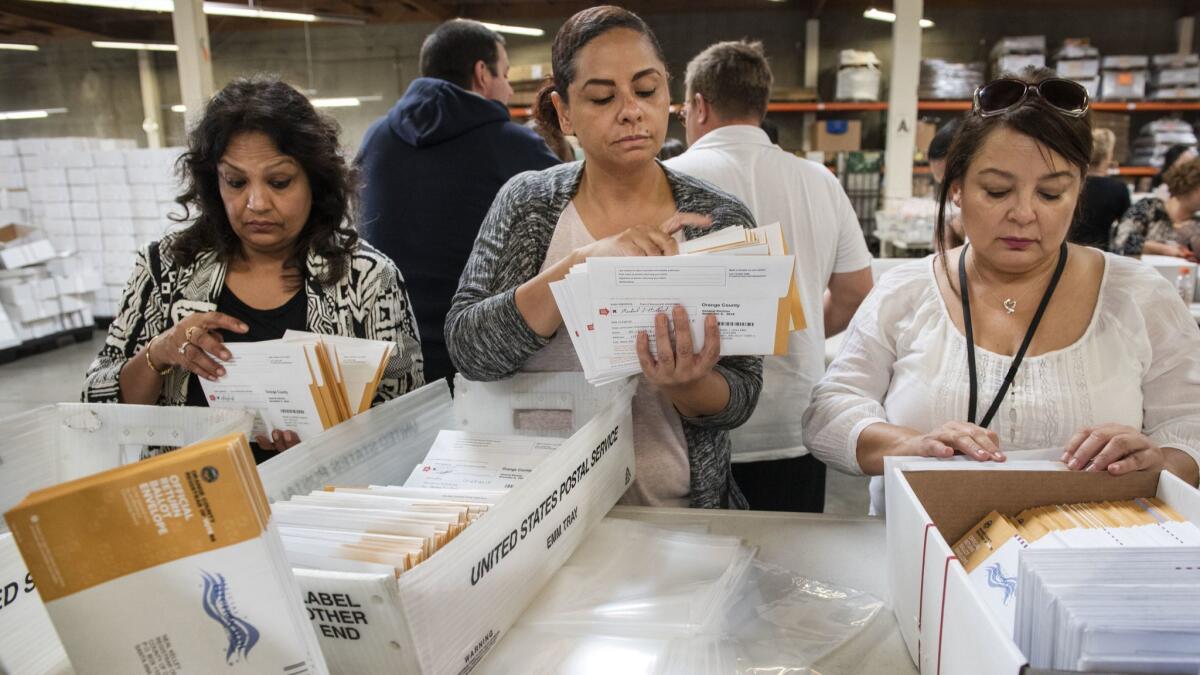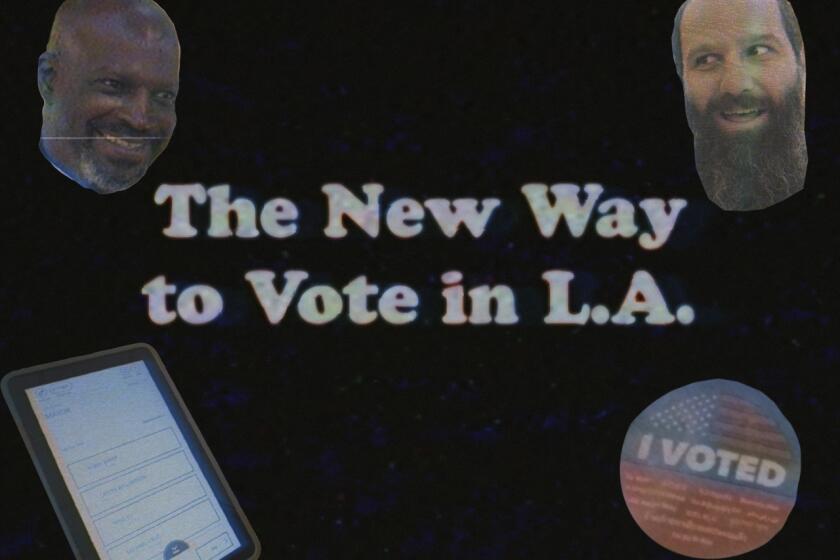Why does it take so long to get election results in California?

- Share via
Last month, the delayed results of the Iowa caucuses caused a crisis within the political world. Fundraising boosts were lost. Momentum was not enjoyed. It did not seem like democracy’s best week.
If the measure of a successful election were only how quickly the results are released, then California would be a disaster. But that’s not how election officials in the state see it as they prepare for the primary election on Tuesday, or Super Tuesday, when California and 13 other states vote. They’re focused on accuracy over speed.
“We prioritize the right to vote and election security over rushing the vote count,” Secretary of State Alex Padilla said in a Feb. 27 statement. “In California, we’d rather get it right than get it fast.”
In other words, don’t stay up for California results on Tuesday.
L.A. ballots have been fully redesigned, thousands of neighborhood polling places have been replaced by fewer regional voting centers and once there, Angelenos will use new touch-screen devices.
How long a wait are we talking about?
County election officials have 30 days to count all ballots and audit the tally. Padilla will then certify the results by April 10.
By the end of this week, elections officials in California’s 58 counties will release their first report of how many ballots remain uncounted. After the 2016 primary, the first report showed some 2.4 million ballots left to be verified and counted.
What? Why does it take so long?
In California, there will be no malfunctioning mobile vote-counting apps and no complicated caucus math to slow things down. There are just a lot of ballots — and some of them arrive after election day.
There are 20.5 million registered voters in California, and the majority of them are expected to mail in their primary ballots. More than 16 million vote-by-mail ballots have been sent out. It’s too early to say how many voters will return their ballots — or decide to vote in person on or before election day — but in California’s 2016 primary, 59% of the votes cast were by mail-in ballots. In the 2018 primary, 68% were.
Unlike in many other states, Californians can wait until election day to take their vote-by-mail ballots to the post office. And as long as those ballots are postmarked on or before election day and arrive at a county election office by Friday, they’ll be counted. The ballots can also be delivered in person on or before election day to a polling place or vote center, a county drop-off box or a local county elections office.
So that’s a lot of ballots coming in well after election night. And that means waiting, maybe even patiently, for returns to come in. As of Friday, 3.3 million mail ballots had been returned.
There’s no provision in California election law for a second chance once a ballot has been mailed or cast in person at a polling place or regional vote center.
Will things be better this year?
Possibly. Under the Voter’s Choice Act, an overhaul of the election process passed in 2016, there’s hope that the number of provisional ballots cast in the election will be reduced. If a voter goes to the wrong voting location on election day, they’re usually given a provisional ballot. The eligibility of those voters takes time to verify, meaning those vote results are delayed. Under the 2016 law, voters in 15 counties are able to go to any vote center in the county in the days leading up to the election, and the vote centers can check their eligibility and register the person to vote, even on election day.
Under the same law, 14 of the 15 counties that implemented the law automatically sent voters a mail-in ballot. Voters in Los Angeles County needed to request a mail ballot by Feb. 25. Some 2 million L.A. County voters didn’t receive an absentee ballot and will have to show up in person to vote.
But, again, don’t expect quick results.
OK, fine. But some of the races will be clear on Tuesday night, right?
In smaller or less competitive races, we should have a good idea of who won within a few hours. In 2016, news outlets called the California presidential primary for former Secretary of State Hillary Clinton the morning after the election, based on the strength of her election night margin against Bernie Sanders, though the Vermont senator did gain a bit on her in late returns.
It’s the competitive races that won’t be decided until every vote is counted. In November 2018, when Democrats flipped control of seven Republican-held seats in the House, several close contests were still up in the air several days after voting concluded.
In four races, the Republican who was leading in election night returns ended up losing once all the mail-in ballots had been counted.
In California’s 39th Congressional District, the race took so long to tally that Young Kim, an Orange County Republican who ran to replace retiring Rep. Ed Royce (R-Fullerton) attended an orientation for House members in Washington. A few days later, Democrat Gil Cisneros was declared the winner.
On March 3, the Democratic presidential campaign will be far from over and the arcane rules for winning in the Golden State will come into play.
What about the presidential primary?
That will be a close race, too. Even if a presidential candidate is declared the “winner” of the California primary this week (or month), we probably won’t know how many delegates that or other candidates won until county election officials complete their vote counts and audits in April.
Of the 494 national delegates in California, 271 of them will be chosen by the results of the 53 congressional districts. Only candidates who win at least 15% of the vote in a district will be eligible for delegates. Those who clear the 15% threshold in the statewide vote total will be awarded portions of 144 at-large and party leader delegates. (Another 79 delegates, a group of elected officials and Democratic National Committee members, aren’t tied to any candidate.)
As the first four early-voting states showed us, a crowded primary can lead to close contests for first, second and third. With four serious contenders still in the race, if the margins are close some campaigns could be hovering around 15% in some districts, waiting to see if they’ll get any delegates at all.
So what am I supposed to do while I wait?
There will be more than a dozen primaries and caucuses in March after Super Tuesday, including six next week. This time next month the California primary could be just a distant memory.
More to Read
Get the L.A. Times Politics newsletter
Deeply reported insights into legislation, politics and policy from Sacramento, Washington and beyond. In your inbox twice per week.
You may occasionally receive promotional content from the Los Angeles Times.













